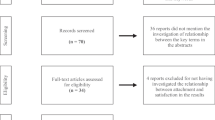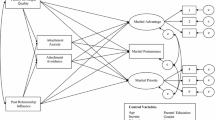Abstract
Maintaining a satisfying heterosexual relationship is important to many individuals’ happiness and physical health. Evolutionary theories on the formation of relationships suggest that adult attachment and relationship commitment are universal mechanisms for securing and maintaining such mating relationships. This study sought to understand how these two mechanisms may link to each other and how they in turn contribute to relationship satisfaction with one’s current partner in Hong Kong Chinese and American cultures. Similarities in the model for relationship satisfaction were found among young dating couples in the United States and Hong Kong. Specifically, attachment anxiety was positively linked to structural commitment, whereas attachment avoidance was negatively related to personal commitment. Both dimensions of attachment (anxiety and avoidance) and both components of commitment (personal and structural) were found to predict current relationship satisfaction significantly and equivalently across cultures, with the pathway from attachment avoidance to current relationship satisfaction similarly mediated by personal commitment in both cultural groups. These results were interpreted in terms of a probable universal logic informing the interpersonal dynamics involving attachment and relationship commitment.


Similar content being viewed by others
References
Adams, J. M., & Jones, W. H. (1997). The conceptualization of marital commitment: An integrative analysis. Journal of Personality and Social Psychology, 72, 1177–1196.
Bartholomew, K., & Horowitz, L. M. (1991). Attachment styles among young adults: A test of a four-category model. Journal of Personality and Social Psychology, 61, 226–244.
Bersoff, D. M., & Miller, J. G. (1993). Culture, context, and the development of moral accountability judgments. Developmental Psychology, 29, 664–676.
Besser, A., & Priel, B. (2008). Attachment, depression, and fear of death in older adults: The roles of neediness and perceived availability of social support. Personality and Individual Differences, 44, 1711–1725.
Birnie, C., Joy, M., Lydon, J. E., & Holmberg, D. (2009). Attachment avoidance and commitment aversion: A script for relationship failure. Personal Relationships, 19, 79–97.
Bowlby, J. (1979). The making and breaking of affectional bonds. London, England: Tavistock.
Brennan, K. A., Clark, C. L., & Shaver, P. R. (1998). Self-report measurement of adult attachment: An integrative overview. In J. A. Simpson & W. S. Rholes (Eds.), Attachment theory and close relationships (pp. 46–76). New York: Guilford Press.
Brennan, K. A., Shaver, P. R., & Clark, C. L. (2000). Specifying some mediators of attachment-related anxiety and avoidance. Unpublished manuscript, State University of New York College at Brockport.
Cann, A., Norman, M. A., Welbourne, J. L., & Calhoun, L. G. (2008). Attachment styles, conflict styles and humour styles: Interrelationships and associations with relationship satisfaction. European Journal of Personality, 22, 131–146.
Coan, J. A. (2010). Adult attachment and the brain. Journal of Social and Personal Relationships, 27, 210–217.
Collins, N. L., & Read, S. J. (1990). Adult attachment, working models, and relationship quality in dating couples. Journal of Personality and Social Psychology, 58, 644–663.
Elliot, A. J., Gable, S. L., & Mapes, R. R. (2006). Approach and avoidance motivation in the social domain. Personality and Social Psychology Bulletin, 32, 378–391.
Feeney, B. C. (2004). A secure base: Responsive support of goal strivings and exploration in adult intimate relationships. Journal of Personality and Social Psychology, 87, 631–648.
Feeney, J. A., & Noller, P. (1990). Attachment styles as a predictor of adult romantic relationships. Journal of Personality and Social Psychology, 58, 281–291.
Feeney, B. C., & Thrush, R. L. (2010). Relationship influences on exploration in adulthood: The characteristics and function of a secure base. Journal of Personality and Social Psychology, 98, 57–76.
Finkel, E. J., Rusbult, C. E., Kumashiro, M., & Hannon, P. A. (2002). Dealing with betrayal in close relationships: Does commitment promote forgiveness? Journal of Personality and Social Psychology, 82, 956–974.
Fraley, R. C., Brumbaugh, C. C., & Marks, M. J. (2005). The evolution and function of adult attachment: A comparative and phylogenetic analysis. Journal of Personality and Social Psychology, 89, 731–746.
Fraley, R. C., & Shaver, P. R. (2000). Adult romantic attachment: Theoretical developments, emerging controversies, and unanswered questions. Review of General Psychology, 4, 132–154.
Frank, E., & Brandstatter, V. (2002). Approach versus avoidance: Different types of commitment in intimate relationships. Journal of Personality and Social Psychology, 82, 208–221.
Gable, S. L. (2006). Approach and avoidance social motives and goals. Journal of Personality, 74, 175–222.
Godwin, R., & Findlay, C. (1997). “We were just fated together”…Chinese love and the concept of yuan in England and Hong Kong. Personality Relationships, 4, 85–92.
Grossmann, K. E., Grossmann, K., & Kepler, A. (2005). Universal and culture-specific aspects of human behavior: The case of attachment. In W. Friedlmeier, P. Chakkarath, & B. Schwarz (Eds.), Culture and human development: The importance of cross-cultural research for the social sciences (pp. 75–97). Hove, England: Taylor & Francis.
Hazan, C., & Shaver, P. R. (1987). Romantic love conceptualized as an attachment process. Journal of Personality and Social Psychology, 52, 511–524.
Hendrick, S. S. (1988). A generic measure of relationship satisfaction. Journal of Marriage and the Family, 50, 93–98.
Hendrick, S. S., Hendrick, C., & Adler, N. L. (1988). Romantic relationships: Love, satisfaction, and staying together. Journal of Personality and Social Psychology, 54, 980–988.
Johnson, M. P. (1991). Commitment to personal relationships. In W. H. Jones & D. W. Perlman (Eds.), Advances in personal relationships (Vol. 3, pp. 117–143). London, England: Jessica Kingsley.
Johnson, M. P. (1999). Personal, moral, and structural commitment to relationships: Experiences of choice and constraint. In J. M. Adams & W. H. Jones (Eds.), Handbook of interpersonal commitment and relationship stability (pp. 73–87). New York: Kluwer.
Johnson, M. P., Caughlin, J. P., & Huston, T. L. (1999). The tripartite nature of marital commitment: Personal, moral, and structural reasons to stay married. Journal of Marriage and the Family, 61, 160–177.
Jones, J. T., & Cunningham, J. D. (1996). Attachment styles and other predictors of relationship satisfaction in dating couples. Personal Relationships, 4, 387–399.
Kelley, H. H. (1983). Love and commitment. In H. H. Kelley, E. Berscheid, A. Christensen, J. H. Harvey, T. L. Huston, G. Levinger, E. McClintock, L. A. Peplau, & D. R. Peterson (Eds.), Close relationships (pp. 265–314). New York: Freeman.
King, A. Y. C., & Bond, M. H. (1985). The Confucian paradigm of man. In W. S. Tseng & D. Y. H. Wu (Eds.), Chinese culture and mental health: An overview (pp. 29–45). Orlando, FL: Academic Press.
Kruger, D. J., & Schlemmer, E. (2009). Male scarcity is differentially related to male marital likelihood across the life course. Evolutionary Psychology, 7, 280–287.
Kurdek, L. A. (2000). Attractions and constraints as determinants of relationship commitment: Longitudinal evidence from gay, lesbian, and heterosexual couples. Personal Relationships, 7, 245–262.
Le, B., & Agnew, C. R. (2003). Commitment and its theorized determinants: A meta-analysis of the Investment Model. Personal Relationships, 10, 37–57.
Lydon, J. E. (1999). Commitment and adversity: A reciprocal relationship. In J. M. Adams & W. H. Jones (Eds.), Handbook of interpersonal commitment and relationship stability (pp. 193–203). New York: Springer.
Lydon, J. E., Meana, M., Sepinwall, D., Richards, N., & Mayman, S. (1999). The commitment calibration hypothesis: When do people devalue attractive alternatives? Personality and Social Psychology Bulletin, 25, 152–161.
Lydon, J. E., Pierce, T., & O’Regan, S. (1997). Coping with moral commitment to long-distance dating relationship. Journal of Personality and Social Psychology, 73, 104–113.
Mallinckrodt, B., & Wang, C. C. (2004). Quantitative methods for verifying semantic equivalence of translated research instruments: A Chinese version of the experiences in close relationships scale. Journal of Counseling Psychology, 51, 368–379.
Markman, H., Stanley, S., & Blumberg, S. L. (1994). Fighting for your marriage. San Francisco, CA: Jossey-Bass.
Masuda, T., & Nisbett, R. A. (2001). Attending holistically versus analytically: Comparing the context sensitivity of Japanese and Americans. Journal of Personality and Social Psychology, 81, 922–934.
Meyers, S. A., & Landsberger, S. A. (2002). Direct and indirect pathways between adult attachment style and marital satisfaction. Personal Relationships, 9, 159–172.
Pistole, M. C., Clark, E. M., & Tubbs, A. L. (1995). Love relationships: Attachment style and the investment model. Journal of Mental Health counseling, 17, 199–209.
Pistole, M. C., & Vocaturo, L. C. (1999). Attachment and commitment in college students’ romantic relationships. Journal of College Student Development, 40, 710–720.
Ramirez, A., Jr. (2008). An examination of the tripartite approach to commitment: An actor-partner interdependence model analysis of the effect of relational maintenance behavior. Journal of Social and Personal Relationships, 25, 943–965.
Rothbaum, F., & Tsang, B. Y. P. (1998). Love songs in the United States and China: On the nature of romantic love. Journal of Cross-Cultural Psychology, 29, 306–319.
Rothbaum, F., Weisz, J., Pott, M., Miyake, K., & Moreli, G. (2000). Attachment and culture: Security in the United States and Japan. American Psychologist, 55, 1093–1104.
Rusbult, C. E., & Buunk, B. P. (1993). Commitment processes in close relationships: An interdependence analysis. Journal of Social and Personal Relationships, 10, 175–204.
Rusbult, C. E., & Verette, J. (1991). An interdependence analysis of accommodation processes in close relationships. Representative Research in Social Psychology, 19, 3–33.
Rusbult, C. E., Verette, J., Whitney, G. A., Slovik, L. F., & Lipkus, I. (1991). Accommodation processes in close relationships: Theory and preliminary empirical evidence. Journal of Personality and Social Psychology, 60, 53–78.
Ryan, R. M., & Deci, E. L. (2000). Self-determination theory and the facilitation of intrinsic motivation, social development, and well-being. American Psychologist, 55, 68–78.
Schindler, I., Fagundes, C. P., & Murdock, K. W. (2010). Predictors of romantic relationship formation: Attachment style, prior relationships and dating goals. Personal Relationships, 17, 97–105.
Sobel, M. E. (1982). Asymptotic confidence intervals for indirect effects in structural equation models. In S. Leinhardt (Ed.), Sociological methodology (pp. 290–312). Washington, DC: American Sociological Association.
van IJzendoorn, M. H., & Sagi, A. (1999). Cross-cultural patterns of attachment: Universal and contextual dimensions. In J. Cassidy & P. R. Shaver (Eds.), Handbook of attachment (pp. 713–734). New York: Guilford.
Wang, Q., & Chang, L. (2010). Parenting and child socialization in contemporary China. In M. H. Bond (Ed.), The Oxford handbook of Chinese psychology (pp. 53–68). New York: Oxford University Press.
Wang, C. C. D., & Matlinckrodt, B. S. (2006). Differences between Taiwanese and US cultural beliefs about ideal adult attachment. Journal of Counseling Psychology, 53, 192–204.
Wieselquist, J., Rusbult, C. E., Foster, C. A., & Agnew, C. R. (1999). Commitment, prorelationship behavior, and trust in close relationships. Journal of Personality and Social Psychology, 77, 942–966.
Wong, C. M. (2009). Effect of religion and religiosity on romantic relationship: Love values and relationship satisfaction (Undergraduate thesis, City University of Hong Kong). Retrieved from http://www.oapsportal.org/handle/123456789/130.
Author information
Authors and Affiliations
Corresponding author
Rights and permissions
About this article
Cite this article
Ho, M.Y., Chen, S.X., Bond, M.H. et al. Linking Adult Attachment Styles to Relationship Satisfaction in Hong Kong and the United States: The Mediating Role of Personal and Structural Commitment. J Happiness Stud 13, 565–578 (2012). https://doi.org/10.1007/s10902-011-9279-1
Published:
Issue Date:
DOI: https://doi.org/10.1007/s10902-011-9279-1




